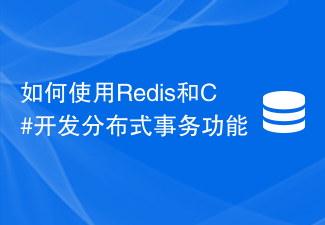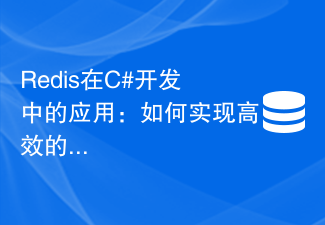Preface
The blogger simply counted the asynchronous articles he has published, and there have been 8 articles intermittently. This time I want to take the return type of async as an example. Talk alone.
Asynchronous methods have three possible return types: Task
When to use which return type? The specific situation requires specific analysis. If used improperly, the execution result of the program may not be what you want. Let's talk about how to choose different return types for different situations.
Task
[Remember] When you add the async keyword, you need to return an object that will be used for subsequent operations, please use Task
Task
In the following example, the GetDateTimeAsync asynchronous method contains a return statement that returns the current time. Therefore, the method declaration must specify Task
async Task<DateTime> GetDateTimeAsync()
{
//Task.FromResult 是一个占位符,类型为 DateTime
return await Task.FromResult(DateTime.Now);
}Call the GetDateTimeAsync method:
async Task CallAsync()
{
//在另一个异步方法的调用方式
DateTime now = await GetDateTimeAsync();
}When GetDateTimeAsync is called from an await expression, the await expression retrieves the DateTime type value stored in the task returned by GetDateTimeAsync.
async Task CallAsync()
{
//在另一个异步方法的调用方式
//DateTime now = await GetDateTimeAsync();
//换种方式调用
Task<DateTime> t = GetDateTimeAsync();
DateTime now = await t;
}The GetDateTimeAsync method is called through the CallAsync method, and the call to the non-immediate waiting method GetDateTimeAsync returns Task
This time I demonstrate different variables, you can compare the results yourself:
async Task CallAsync()
{
//在另一个异步方法的调用方式
DateTime now = await GetDateTimeAsync();
//换种方式调用
Task<DateTime> t = GetDateTimeAsync();
DateTime now2 = await t;
//输出的结果对比
Console.WriteLine($"now: {now}");
Console.WriteLine($"now2: {now2}");
Console.WriteLine($"t.Result: {t.Result}");
}[Note] The Result attribute is a locked attribute. If you try to access it before its task is completed, the currently active thread will be blocked until the task completes and the value is available. In most cases, you should access the property value by using await rather than accessing the property directly.
Task
Asynchronous methods that do not contain a return statement or contain a return statement that does not return an operand usually have a return type of Task. If written to run asynchronously, these methods will be void-returning methods. If you use the Task return type in an asynchronous method, the calling method can use the await operator to pause the caller's completion until the called asynchronous method completes.
See example:
async Task DelayAsync()
{
//Task.Delay 是一个占位符,用于假设方法正处于工作状态。
await Task.Delay(100);
Console.WriteLine("OK!");
}Call and await the DelayAsync method by using an await statement instead of an await expression, similar to the call statement for a method that returns void. The application of the await operator does not produce a value in this case.
See the example of calling DelayAsync.
//调用和等待方法在同一声明中 await DelayAsync();
Now, I use a method that separates calling and waiting:
//分离 Task delayTask = DelayAsync(); await delayTask; void
void return type is mainly used in event handlers, where void return type is required. The void return type can also be used as an alternative to methods that return void, or for methods that perform activities that can be classified as call-and-forget activities. However, you should return Task whenever possible because you cannot await asynchronous methods that return void. Any caller of such a method can only proceed to completion without waiting for the called asynchronous method to complete, and the caller must be independent of any values or exceptions generated by the asynchronous method.
Callers of an asynchronous method that returns void cannot catch exceptions thrown from the method, and such unhandled exceptions may cause application failures. If an exception occurs in an asynchronous method that returns a Task or Task
Now, exceptions can also use await, please move here "Looking back at the past and present of C# - Witness the new syntax features of C# 6.0".
void return value example:
private async void button1_Click(object sender, EventArgs e)
{
//启动进程并等待完成
await Task.Delay(100);
}The above is the C# basic review of the return type of Async. For more related content, please pay attention to the PHP Chinese website (www.php.cn)!
 如何使用C#编写时间序列预测算法Sep 19, 2023 pm 02:33 PM
如何使用C#编写时间序列预测算法Sep 19, 2023 pm 02:33 PM如何使用C#编写时间序列预测算法时间序列预测是一种通过分析过去的数据来预测未来数据趋势的方法。它在很多领域,如金融、销售和天气预报中有广泛的应用。在本文中,我们将介绍如何使用C#编写时间序列预测算法,并附上具体的代码示例。数据准备在进行时间序列预测之前,首先需要准备好数据。一般来说,时间序列数据应该具有足够的长度,并且是按照时间顺序排列的。你可以从数据库或者
 如何使用Redis和C#开发分布式事务功能Sep 21, 2023 pm 02:55 PM
如何使用Redis和C#开发分布式事务功能Sep 21, 2023 pm 02:55 PM如何使用Redis和C#开发分布式事务功能引言分布式系统的开发中,事务处理是一项非常重要的功能。事务处理能够保证在分布式系统中的一系列操作要么全部成功,要么全部回滚。Redis是一种高性能的键值存储数据库,而C#是一种广泛应用于开发分布式系统的编程语言。本文将介绍如何使用Redis和C#来实现分布式事务功能,并提供具体代码示例。I.Redis事务Redis
 如何实现C#中的人脸识别算法Sep 19, 2023 am 08:57 AM
如何实现C#中的人脸识别算法Sep 19, 2023 am 08:57 AM如何实现C#中的人脸识别算法人脸识别算法是计算机视觉领域中的一个重要研究方向,它可以用于识别和验证人脸,广泛应用于安全监控、人脸支付、人脸解锁等领域。在本文中,我们将介绍如何使用C#来实现人脸识别算法,并提供具体的代码示例。实现人脸识别算法的第一步是获取图像数据。在C#中,我们可以使用EmguCV库(OpenCV的C#封装)来处理图像。首先,我们需要在项目
 Redis在C#开发中的应用:如何实现高效的缓存更新Jul 30, 2023 am 09:46 AM
Redis在C#开发中的应用:如何实现高效的缓存更新Jul 30, 2023 am 09:46 AMRedis在C#开发中的应用:如何实现高效的缓存更新引言:在Web开发中,缓存是提高系统性能的常用手段之一。而Redis作为一款高性能的Key-Value存储系统,能够提供快速的缓存操作,为我们的应用带来了不少便利。本文将介绍如何在C#开发中使用Redis,实现高效的缓存更新。Redis的安装与配置在开始之前,我们需要先安装Redis并进行相应的配置。你可以
 如何使用C#编写动态规划算法Sep 20, 2023 pm 04:03 PM
如何使用C#编写动态规划算法Sep 20, 2023 pm 04:03 PM如何使用C#编写动态规划算法摘要:动态规划是求解最优化问题的一种常用算法,适用于多种场景。本文将介绍如何使用C#编写动态规划算法,并提供具体的代码示例。一、什么是动态规划算法动态规划(DynamicProgramming,简称DP)是一种用来求解具有重叠子问题和最优子结构性质的问题的算法思想。动态规划将问题分解成若干个子问题来求解,通过记录每个子问题的解,
 C#开发中如何处理跨域请求和安全性问题Oct 08, 2023 pm 09:21 PM
C#开发中如何处理跨域请求和安全性问题Oct 08, 2023 pm 09:21 PMC#开发中如何处理跨域请求和安全性问题在现代的网络应用开发中,跨域请求和安全性问题是开发人员经常面临的挑战。为了提供更好的用户体验和功能,应用程序经常需要与其他域或服务器进行交互。然而,浏览器的同源策略导致了这些跨域请求被阻止,因此需要采取一些措施来处理跨域请求。同时,为了保证数据的安全性,开发人员还需要考虑一些安全性问题。本文将探讨C#开发中如何处理跨域请
 如何实现C#中的遗传算法Sep 19, 2023 pm 01:07 PM
如何实现C#中的遗传算法Sep 19, 2023 pm 01:07 PM如何在C#中实现遗传算法引言:遗传算法是一种模拟自然选择和基因遗传机制的优化算法,其主要思想是通过模拟生物进化的过程来搜索最优解。在计算机科学领域,遗传算法被广泛应用于优化问题的解决,例如机器学习、参数优化、组合优化等。本文将介绍如何在C#中实现遗传算法,并提供具体的代码示例。一、遗传算法的基本原理遗传算法通过使用编码表示解空间中的候选解,并利用选择、交叉和
 如何实现C#中的图像压缩算法Sep 19, 2023 pm 02:12 PM
如何实现C#中的图像压缩算法Sep 19, 2023 pm 02:12 PM如何实现C#中的图像压缩算法摘要:图像压缩是图像处理领域中的一个重要研究方向,本文将介绍在C#中实现图像压缩的算法,并给出相应的代码示例。引言:随着数字图像的广泛应用,图像压缩成为了图像处理中的重要环节。压缩能够减小存储空间和传输带宽,并能提高图像处理的效率。在C#语言中,我们可以通过使用各种图像压缩算法来实现对图像的压缩。本文将介绍两种常见的图像压缩算法:


Hot AI Tools

Undresser.AI Undress
AI-powered app for creating realistic nude photos

AI Clothes Remover
Online AI tool for removing clothes from photos.

Undress AI Tool
Undress images for free

Clothoff.io
AI clothes remover

AI Hentai Generator
Generate AI Hentai for free.

Hot Article

Hot Tools

SublimeText3 Chinese version
Chinese version, very easy to use

SublimeText3 English version
Recommended: Win version, supports code prompts!

MantisBT
Mantis is an easy-to-deploy web-based defect tracking tool designed to aid in product defect tracking. It requires PHP, MySQL and a web server. Check out our demo and hosting services.

Dreamweaver CS6
Visual web development tools

WebStorm Mac version
Useful JavaScript development tools





